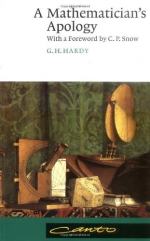|
This section contains 346 words (approx. 1 page at 400 words per page) |

|
A Mathematician's Apology Summary & Study Guide Description
A Mathematician's Apology Summary & Study Guide includes comprehensive information and analysis to help you understand the book. This study guide contains the following sections:
This detailed literature summary also contains Bibliography on A Mathematician's Apology by G. H. Hardy.
Godfrey Harold (G. H.) Hardy's A Mathematician's Apology, first published in 1940 in England, is the memoir of the world-renowned mathematician, written in the last few years of his life while he was in failing health. The work is written in the form of an apology, which in literary terms means a defense. In this case, Hardy is defending his career as a theoretical mathematician. To make the defense comprehensible to the layperson, Hardy discards the language he would use in an academic paper and instead adopts a succinct and simple writing style aimed at a general audience. The book is not mathematical; rather, it is an affirmation of a career that happens to be mathematical and purely speculative.
It should be noted that Hardy speaks exclusively of men in his writing, which reflects the secondary role women of his era played in the British university system in general and in the field of mathematics in particular. Hardy does not mention or refer to a single woman intellectual or a work by a woman
A Mathematician's Apology is a lasting testament to Hardy's passion for intellectual pursuits. Hardy likens mathematics to art and explains math in much the same way a critic explains art. He elaborates on the qualities of mathematical genius and the logical reasons for pursuing a career in mathematics, and he briefly outlines three of the most basic and timeless theorems in order to illustrate the inherent beauty of mathematics for the layperson. Many of the chapters also address the differences between theoretical or "pure" mathematics to which Hardy dedicated his lifeand several types of "applied math," which he regards as largely inferior. The work also reveals the grave doubts Hardy harbored about the overall usefulness of his work and life. While A Mathematician's Apology has had an enormous influence on generations of mathematicians, it has also been viewed by many as a psychological document of a genius with depressive tendencies. As Hardy contemporary C. P. Snow acknowledges in the book's introduction, A Mathematician's Apology "is a book of haunting sadness."
Read more from the Study Guide
|
This section contains 346 words (approx. 1 page at 400 words per page) |

|



